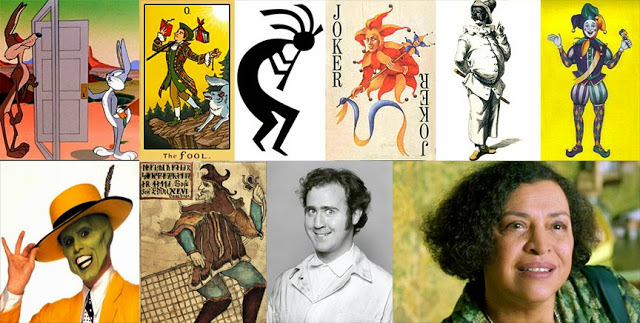| Online: | |
| Visits: | |
| Stories: |
The Dancing Trickster of Love in NYC
Performance Artist Matthew Silver: The Dancing Trickster of Love in NYC
One of the things that has always fascinated me was the ability of art, artists, music, musicians, satirists, comedians, and other performers to shatter programming, illusions, and habitual patterns in people. Its also the reason they are often the first to persecuted by religions, dictators, and another control freaks who have no sense of humor or art in their soul. We have been programmed to expect wisdom and truth to come from men in pin striped grey suits..
Yet the trickster archetype endures throughout the eons the cosmic joke that laughs at the illusion and seriousness.. see below the videos for an interesting article on the trickster archetype… the un-balancer of rigid equations… should you choose to inquire more on that…
“I love all of you!”
[iv] It is also noteworthy that the Trickster seems to be universally male. However Hyde remarked: “All the standard tricksters are male. There are three related reasons why this might be”.
[v] The three reasons are that the tales come from patriarchal mythologies, that possible female tricksters have just been ignored, and that, as Hyde put it: “..the trickster stories articulate some distinction between men and women, so that even in a matriarchal setting this figure would be male”. Perhaps it is fitting to introduce immediately the character of this figure by citing from Hyde’s introduction to his book: “Trickster is the mythic embodiment of ambiguity and ambivalence, doubleness and duplicity, contradiction and paradox”.
[vi] Most significantly, the Trickster is famous for crossing boundaries and breaking taboos. In certain contexts these attributes raise the role of the Trickster from a social misfit to a transpersonal savior. As Hynes puts it: “The trickster is often a psychopomp, a mediator who crosses and resets the lines between life and death….The trickster quite regularly brings gifts essential to human culture, usually by breaking a central taboo established in the divine order.”
[vii] Thus, in addition to the little animals as Brer Rabbit and Reynard the Fox in our Western folktales, and in addition to more mischievous and clearly anti-social characters, there are Trickster heroes who have brought bounties for mankind, including the Greek Prometheus and Hermes and the Hawaiian Maui. There are even historical characters, such as St. Peter who have been thought of by some cultures as embodying trickster traits.
[viii] It was Jung, of course, whom I also would have read before that talk in Houston, who was the most salient in describing the psychology of the Trickster. He suggested that there was a definite relationship between this figure and what Jung had called the Shadow. In a striking passage, he wrote: “The so-called civilized man has forgotten the trickster. He remembers him only figuratively and metaphorically, when, irritated by his own ineptitude, he speaks of fate playing tricks on him or of things being bewitched. He never suspects that his own hidden and apparently harmless shadow has qualities who dangerousness exceeds his wildest dreams”.
[ix] Jung further extended on the frequently humorous side of the Trickster, where the associated figures of the joker, the clown, the pranker, and sometimes even the buffoon are displayed. Jung showed how these characteristics appeared at times in history, including the medieval church (when the mass was sometimes celebrated with an ass). As I said in my 1965 talk in Houston:” Laughter is primarily a release from tension. From this vantage point the Trickster figure and all that it implies acts complementarily to the over-reverential and compulsive elements of the ritual; social or religious or socio-religious.“
[x] In addition to this, the very appellate ‘don Juan’ suggests the name of the legendary Spanish love hero; indeed his sexual exploits uncannily resembled Castaneda’s own traits in that field (see p. 412). The don Juan of literature first appeared in the play by Tirso de Molina called (in Spanish) El Burlador de Sevilla sometime before 1620. Sevilla of course is the town of Seville, but the name Burlador “means literally ‘trickster’, but with the strong connotation of ‘seducer’ or ’seducer-jokester”.
[xi] If this was not enough, the Trickster according to some writers, looms heavily in paranormal effects. This essentially is the content of two books: The Trickster and the Paranormal by George P. Hansen, and Synchronicity: Science, Myth, and the Trickster by Allan Combs and Mark Holland
[xii], both of which we will be shortly quoting from. Jung’s essay also made the same point. We need now to indicate the main examples in Life Dreams that suggest the hand of the Trickster.
[xiv] Combs and Holland focus on the role of the Trickster in synchronicity occurrences: “One archetype that we have already looked at in some detail is of particular importance to synchronicity: the archetype of the Trickster. He is the mythic embodiment of the unexpected”.
[xv] In quoting from this book, in view of the enormous weight played by symbols in Life Dreams, it was impossible not to miss this passage: ” The Trickster delights in frolicking with symbols. Synchronicity in such instances seems to mirror processes that are afoot deep in the psyche.“
[xvi] Both books also seem to agree on the attribute of the Trickster of breaking boundaries. For example, Combs and Holland: “We seem most accessible to the synchronistic gifts of the Trickster when we ourselves are at or near boundaries or are experiencing transition states.”
[xvii] Hansen extends this point by placing a major emphasis on the contrast between structure and anti-structure – a thesis amplified by some anthropologists – processes which are always in play both in society and within the individual, providing the transition between order and disorder. This distinction is implicit in our discussion in the Commentary on The Opposites. It is at the turning point from order to disorder, in that ambiguous zone which has been called ‘liminality’ that the Trickster holds sway. Hansen writes: “Liminality involves blurring of distinctions and oppositions such as life-death, male-female, and food-excrement”.
[xviii] Combs and Holland especially focused on one of the more helpful tricksters, the Greek god Hermes. It is pertinent to note that in Life Dreams I introduced a big hint as to the producer of the playful synchronicities during the Tucson trip (see p.347) with a little fantasy about the child Hermes and his mother. At this time my intuition was not influenced by the statement that I later found in the book by Combs and Holland that Hermes had a connection with the Great Mother goddess: “Hermes, as an expression originating from the great goddess, is connected in the most intimate way to the ultimate source of all life, long represented by that goddess.”
[xix] In general the book by Combs and Holland stress the helpful side of the Trickster, especially in the quest of achieving wholeness, what Jung called individuation: “As in other instances of individuation, the play of the Trickster may assist the individual’s quest in a variety of ways.”
[xx] On this point I was very much reminded of what my fiend Hyemeyohsts Storm had to say on the matter: “The coyote…is symbolic of the Gentle Trickster. He represents all those things that trick us into learning.”
[xxi] I often wondered about Storm himself – there were times when he acted as what some Native Americans called the Contrary (see p.316 Life Dreams) – and I was then reminded of what he said about a mythical character in his book: ” Vihio, which also means ‘white’, is symbolic of the North, or Wisdom. But we all know that Vihio is also the Contrary. He is a clown. He is a knowledgeable fool”.
[xxii] It had also struck me forcibly that this entire enterprise – the very first anomalous happenings, all the other incidents, writing the book, writing these Commentaries, turning my life upside down, all began with a seemingly absurd (at the time) suggestion of Castaneda displaying his Ally (see Chapter 1 of my book). As I wrote in my book, p.9, Castaneda had proposed the same suggestion to someone else entirely, and he had never followed through the idea with this person.
[xxiii] In my own case, I have often wondered who was the Trickster and who was the Tricked. After all, from the very beginning I had spotted the subtle hand of the Trickster in Castaneda’s tale of the bilingual coyote (see p.6). It all began in a spirit of play, a kind of adventure appealing to my temperament. If I had known what would entail would I have embarked on this venture? Perhaps I needed to be tricked. As Combs and Holland mentioned: “When we allow this play, the Trickster brings insights about out unconscious hopes, fears, and passions. In doing so he frees us from the compulsion to act out motives we do not understand”.
[xxiv] A further possible sign of the Trickster is what Hansen has called ‘Reflexivity’. As he defined it: “Reflexivity is the turning of some function or process back upon itself, as in using awareness to learn about awareness or using logic to study logic”.
[xxv] Something of the sort certainly occurred in one of the most striking synchronicities of the book. This was the synchronicity described in pp. 368-372, of finding that the mysterious Mariano, who had at first appeared in dreams in Los Angeles, then in various other strange contexts, and finally emerged to be a real Native American living in Taos, turned out to be the son of the man that Jung had met in the Taos Pueblo back in the nineteen-twenties. As it was Jung’s psychology that had provided me with the basic map that helped me understand all these anomalous occurrences, this Mariano finding was a true reflexivity. The reflexivity factor had not completely escaped me at the time of writing the book. The incident of the Scarab (described in Chapter 5) was noted by me as implying this, in the Prologue to Life Dreams: “..it was the image of the scarab in one of our dreams that escalated our attention to possible paranormal events – the scarab being the very example in which Jung first discussed synchronicity.”(p.xx) And on p.385 I noted it quite explicitly: “It also was becoming clear to me that there was a reflexive element operating. What, and how, I understood had an effect on the symbols in dreams: or at least in my own dreams. I was still perplexed as to how this could influence the dreams of other people regarding me, but a reflexive principle was nevertheless operating”.
[xxvi] In this book von Franz is using the word ‘reflection’ in the original sense of throwing back of light or heat, based on the Latin reflexio. It is in this sense that some of the paranormal events described in my book might be envisaged.
[xxvii]. Mac Linscott Ricketts, on the other hand, thought of the Trickster and the Shaman as opposites
[xxviii]. In my concluding chapter I qualified the latter view by considering that both figures were personifications of the qualities needed to make the transition from personal to transpersonal. As such, if indeed they were opposites, that they were complementary opposites, that they were positioned at different places on the personal-transpersonal cycle. This suggestion, of course, is quite speculative. It is difficult to make any firm statement on such a nebulous figure as the Trickster; if one makes any assertion there will be some tale, some description that will negate it. As Hansen has put it in his concluding chapter on his book about this character: “The trickster has innumerable internal contradictions, and those are what have made him so difficult for scholars…The usual scientific concepts are inadequate to fully explain him. He has many meanings and cannot be reduced to a single category. He resists being placed in any single category.“
[xxix] I would have no disagreement about this.







